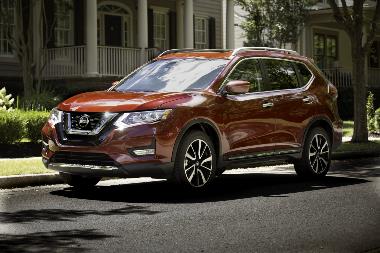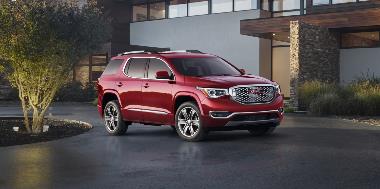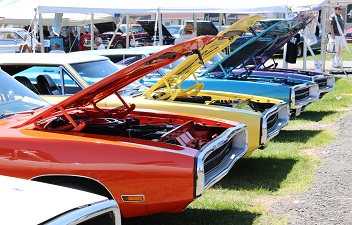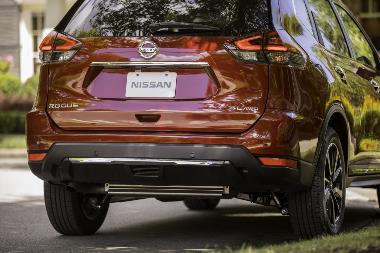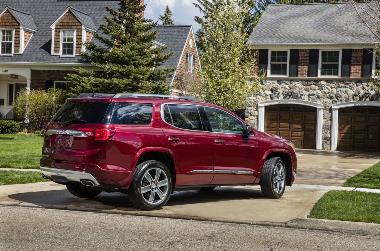The GMC Acadia was launched in 2006 for the 2007 model year, and was re-engineered for 2017 as a second-Gen mid-size crossover that is smaller, lighte
…
The GMC Acadia was launched in 2006 for the 2007 model year, and was re-engineered for 2017 as a second-Gen mid-size crossover that is smaller, lighter, and more technically and cosmetically advanced than the original, with hipper styling cues. Offering greater maneuverability than the first-generation model, this second-Gen sports-ute is a sibling to the Chevrolet Traverse and shares the same platform and mechanical components with its midsize sister, but most everything else, from grillework, to interior styling to equipment, differs, as Acadia is more trendy, round and intuitive inside, while Traverse seems to be more pedestrian.
New for 2019 are the Acadia Black Edition that is available on SLT model and includes 20-inch machined aluminum wheels with black accents, black grille insert , black surround, black headlamp and taillamp details, and black mirror caps, roof rails and additional exterior accents. Also new are a 17-inch wheel design and P255/65R17 all-terrain tires available on All Terrain, as well as new exterior colors: Dark Sky Metallic, Pepperdust Metallic, Red Quartz Metallic and Smokey Quartz Metallic.
Vehicle highlights include: Traction Select that allows driver to adjust vehicle performance for various road conditions; active upper and lower grille shutters; power programmable liftgate; three rows of seating, including second-row captain’s chairs or split-folding bench; tri-zone automatic climate control; standard GMC Infotainment system with 7-inch-diagonal color touchscreen, and an available 8-inch system with navigation. Other Acadia amenities include Apple CarPlay and Android Auto phone projection capability; Teen Driver is standard on all models; Keyless Open and Start is standard on all models and an available Tow Vision Trailering System, which uses the rear-vision camera to help line up the hitch with a trailer.
I tested the upscale Denali, built at GM’s Spring Hill, Tennessee assembly facility with 65 percent U.S./Canadian parts. With body-frame integral construction, the structure incorporates press-hardened, high-strength steels, which allows thinner components in some areas offering comparable or better crash performance than conventional materials as well as providing reduced curb weight.
A refined mid-size crossover, Acadia measures 193.6 inches long; 66 inches high and a widebody 75.4 inches wide on a 112.5-inch wheelbase. Ground clearance is 7.2 inches and curbweight comes in at about 3956, though the upscale versions with the 3.6-liter engine should exceed 4000 pounds.
Acadia offers two engine choices: a 2.5-liter Inline-4 engine that provides 193hp and 188 lbs.-ft. of torque and an EPA rating of 21/city and 26/highway; or a 3.6-liter V-6 engine mated to a Hydra-Matic 6T70 six-speed automatic transmission. The system delivers 310 hp and 271 lbs.-ft. of torque, for an EPA rating of 18/city and 25/highway. Mated to a 6T70 six-speed automatic transmission, my 3.6-powered Denali was attentive, responsive and confident, and averaged 21.1 mpg with long stretches of highway cruising making up the largest part of my tests.
Providing a sporty and comfortable driving experience, Acadia’s electric variable-effort power steering with Active Return Assist was predictable, and minimized body roll and understeer in corners, while the MacPherson strut front suspension with direct-acting stabilizer bar worked well with the five-link independent rear with coil springs and stabilizer bar to level highway and city road irregularities. Softroad excursions were fun, but I am not sure Acadia is a true off-roader.
Generous and well-appointed inside, the Acadia cabin provides seating for five, six, or seven passengers depending on model and configuration. My six-passenger Denali offered a roomy 40.3 inches of front headroom without a sunroof (you lose about 1.2 inches with a sunroof), and 39.6 in row two. The third row allows 37.2 inches. Legroom was 41 inches in front and 39.7 in the second row and a child-worthy 31.1 in row three, while shoulder room came in at 59.4, 58.7 and 54.3 Cargo volume was 41.7 cu.ft. behind row two if row three is eliminated.
Safety features include standard head curtain side air bags with rollover protection for all seating rows and roof-mounted head curtain air bags, Front and Rear Parking Assist, Lane Change Alert, Front Pedestrian Braking, Low Speed Forward Automatic Braking, Forward Automatic Braking, Following Distance Indicator, IntelliBeam automatic headlamp high-beam control, Surround Vision camera system, Forward Collision Alert and more.
Acadia’s base SL trim starts at $30,195 and runs through six levels to get to the top-of-the-line Denali that I tested – starting at $46,695. In the lesser trims, you pay about $1095 for the upgrade to the larger engine – Denali comes with the larger plant as standard. You also pay from $2000 to $5000 to upgrade from FWD to AWD depending on trim level, the higher the level the less the increase, so with Denali, we were only hiked by $2000 for AWD. Red Quartz Tincoat exterior paint added $495 and the outside was mated to a Jet Black perorated leather interior. The Technology Package that is a “must” for the safety conscious was also included for $1495, consisting of advanced adaptive cruise control with full speed front automatic braking and a surround vision system. The Interior Protection Package for $300 added all-weather floor mats and cargo mats throughout. Rear seat infotainment with DVD player would have added $1995, but my ride was without that option, though we did add Wireless charging for $375. With an additional $1195 for Destination charges, my final sticker-as-tested was at $51,460, but cash allowance incentives of $4250 brought the MSRP to $47,210, so check with your local dealer.
<I> Visit www.CarlisleEvents.com for more on the automotive hobby.
Mike Blake, former editor of KIT CAR magazine, joined Carlisle Events as senior automotive journalist in 2004. He's been a "car guy" since the 1960s and has been writing professionally for about 30 years. </I>
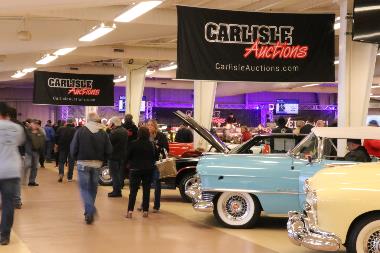
.tmb-thumb380.jpg?sfvrsn=9668452c_2)
